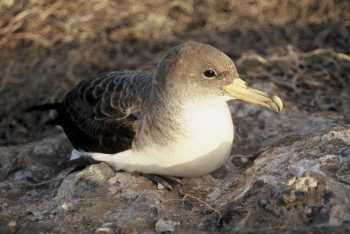
Cory’s Shearwater, photograph by Paulo Catry
Beneharo Rodríguez (Canary Islands’ Ornithology and Natural History Group, Buenavista del Norte, Canary Islands, Spain) and colleagues have published open access in the journal Biological Invasions on effects of Introduced predators (cats and rats) and nest competitors (such as feral pigeons Columbia livia and Cory’s Shearwaters Calonectris borealis) on Bulwer’s Petrels Bulweria bulwerii in the Canary Islands.
Co-author Airam Rodríguez writes to ACAP Latest News "The bulk of Bulwer's Petrel breeding pairs is currently restricted to geographically small secure breeding sites (mostly marine rocks) due to predation by introduced mammal predators, collisions with electricity transmission wires, road casualties, habitat destruction, and attraction to artificial night lights. We highlight an overlooked threat to these petrel sanctuaries: pigeon competition for nesting sites that can cause more than 7.3% of breeding failure. In addition, we have also compiled a non-exhaustive list of evidence of interactions between feral pigeons and other seabirds (15 species!) across the world."
The paper’s abstract follows:
“Petrels are particularly sensitive to predation by introduced species. Many populations have reduced their breeding ranges, currently mainly occupying predator-free sites. Breeding range reduction leads to interspecific competition for nesting sites, which can be detrimental to petrels. Here, we evaluate how the presence of introduced mammals (cats Felis catus and rats Rattus spp.) and potential competitors for nest sites (Cory’s shearwaters Calonectris borealis and feral rock pigeons Columba livia) shape the distribution, breeding density, and breeding performance of Bulwer’s petrel Bulweria bulwerii on Tenerife, the largest and most densely human populated of the Canary Islands. We estimated nest density, assessed the role of nest location and physical characteristics of nests on breeding success, and determined causes of breeding failure by introduced predators and competitors. Nest density was higher in predator-free colonies on marine rocks. Cat presence was the best predictor of nest density, but it was not correlated with either presence or abundance of competitors. Breeding success varied between years and colonies but was not related to nest characteristics. Pigeon competition for nests was the most frequent cause of breeding failure (7.3%), followed by rat predation (6.3%). We also compared petrel and pigeon nest cavities and found considerable overlap in the physical size of nest sites. Our study provides insights into an overlooked impact of the invasive rock pigeon: nest competition with small seabirds. We encourage more research on the effects of pigeons on nest density, as well as disease and pathogen transmission, and vegetation changes within seabird colonies.”
With thanks to Airam Rodríguez.
Reference:
Rodríguez, B., Rodríguez, A., Siverio, F., Martínez, J.M., Sacramento, E. & Acosta, Y. 2002. Introduced predators and nest competitors shape distribution and breeding performance of seabirds: feral pigeons as a new threat. Biological Invasions doi.org/10.1007/s10530-022-02746-1.
John Cooper, ACAP Information Officer, 02 March 2022

 Español
Español  English
English  Français
Français